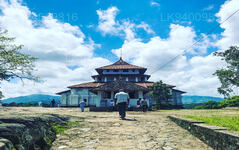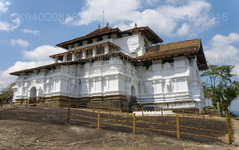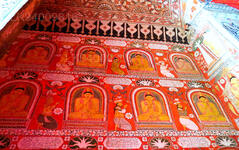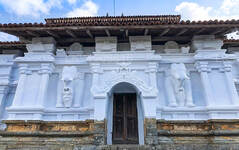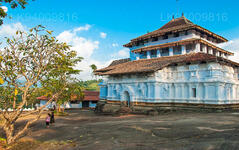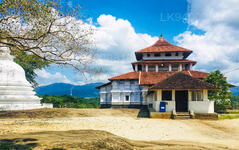
Kandy City
Kandy, a picturesque city in central Sri Lanka, is renowned for its rich cultural heritage, vibrant festivals, and scenic beauty. Nestled amidst lush hills, it is home to the Temple of the Tooth Relic, a UNESCO World Heritage Site, and offers a captivating blend of history and natural splendor.
Lankathilaka Viharaya
Lankathilaka Viharaya in Sri Lanka: The Great Temple of the Kings
Lankatilaka is Buddhist temple of the 14th century in the Hiyarapitiya village, from the Udu Nuwara area of Kandy district in Sri Lanka. This historical temple was built by the Gampola king, King Buwanekabahu the fourth (1341 – 1351AD), in 1344 AD. Gampola was a stronghold on the banks of Mahaveli River.
Lankathilaka Viharaya in Sri Lanka: Architectural Facts
- The temple was designed by the South Indian architect Sthapati Rayar.
- According to the opinions of researchers; the temple combines the design elements of the Polonnaruwa era architecture with that of Dravidian (India) and Indo-Chinese design. At the time of construction the temple was a four storied edifice of eighty feet, built on uneven bedrock using a granite based foundation.
- The temple structure is such that it radiates from the centre in the four cardinal directions, like a cross. Only then ground floor and part of the first floor of the original temple can be seen today, though the temple appears to have three stories from the outside.
- The thick outer walls of the Temple have beautifully sculpted arches and various sculptures making it a unique design of the 14th century.
Lankathilaka Viharaya in Sri Lanka: Sights when entering the Temple
- There are two directions of approach to the temple. One of them has abodes for Buddhist monks at the base of the rock.
- The premises also have many sights such as the huge rice storage bins, known as ‘Atuwa’ by the locals. The stairs begin in the premises of the abodes.
- The other method of approach is from the west of the temple.
- With two ways of approach come two different flights of stairs. One is the original flight built in the 14th century, while the other is more recent; built around 1913. The stairs are cut into the living rock of Pahangalla and provide a climber with beautiful views of the surrounding countryside.
- At the top of the old flight of stairs, the premises of the temple can be entered through a primitive stone door arch, created with three long pieces of rock affixed together.
Lankathilaka Viharaya in Sri Lanka: The Temple
The temple premises have three sectors; the actual temple building, the Dagoba or stupa and finally the Bo tree.
The temple like the flights of stairs has two entrances, leading to two different and disconnected sections in the same building. The main and most important sector is the eastern section, the Buddha Image House. The other is on the west, the the Temples of the Gods.
The Buddha Image House
- The Buddha Image House which is approached from the eastern entrance, right in front of the eastern flight of stairs, and has a Moonstone adorning the ground before the entrance.
- Def. Moonstone: A semi-circular piece of stone which stands at the foot of a flight of steps in most historical Buddhist buildings.
- Two balustrades carved with the Gajasinha or elephant headed lion hybrid design flank the short flight of stairs leading to the entrance archway of the temple.
- The outer archway has a Makara Torana or dragon figure with some unique characteristics that differentiate it from the usual Makara Toranas.
- On the wide inside side walls of the archway display wonderfully preserved paintings of lions. A pair of guardian statues stands close to the wooden door, which has several panels painted with creepers and various designs.
- The inside of the Buddha Image House is an art masterpiece in its entirety with the walls and ceiling completely covered in beautiful paintings dating back to the construction of the temple.
- The pigments used are mostly red, white, yellow and black; with red being the dominant colour possibly because ochre was a pigment that could last the ravages of time.
- The paintings depict the lives of the 24 former Buddhas on the walls, while the ceiling has an abstract flower design.
- The centrepiece of the Buddha Image House is a beautiful golden toned seated Buddha statue. Above the statue is another Makara Torana with sculptures of angels watching over.
Lankathilaka Viharaya in Sri Lanka: Rock Inscriptions
There are inscriptions cut into the rock surface on the temple premises. The inscriptions are both in Sinhala and Tamil, stating that the land was gifted to the Temple by the kings and describing other facilities offered to the temple.
The Lankatilaka Temple is a beautiful cultural heritage of Sri Lanka that has to be visited on a holiday to the country. This temple along with the Embekke temple remains one of the most architecturally advanced structures of the Gampola Kingdom era.
About Kandy District
Kandy district is situated in the centrel province of Sri Lanka. One of the seven World Heritage Sites in Sri Lanka, Kandy was once home to the Kandyan Kings of yore in the 16th-century and a fountainhead for all the music, arts, crafts and culture in the country. About 129 km away from Colombo, Kandy is ensconced amongst a hilly terrain and all eyes are drawn to the centre of the city, where the Kandy Lake forms a charming feature. Kandy retains great religious significance for Sri Lanka, because it is in this charming city that the Dalada Maligawa or "Temple of the Tooth" is located, within which the sacred tooth relic of Lord Buddha lies well guarded.
The Royal Botanical Garden, Peradeniya is situated about 5 km to the west of the city centre at Peradeniya and is visited by 1.2 million people per year. It is the largest botanical garden on the island. The Udawatta Kele (Udawatta Forest) is a protected sanctuary situated in the heart of the city, just north of Temple of the Tooth.
Kandy is a Sinhala majority city; there are sizeable communities belonging to other ethnic groups, such as Moors and Tamils. Kandy is second only to Colombo the center of the Sri Lankan Economy. Many major co operations have large branch officers in Kandy and many industries include textiles, furniture, Information Technology and jewellery are found here. Many agriculture research centers are located in the city.
And a fountainhead for all the music, arts, crafts and culture in the country. About 129 km away from Colombo, Kandy is ensconced amongst a hilly terrain and all eyes are drawn to the centre of the city, where the Kandy Lake forms a charming feature. Kandy retains great religious significance for Sri Lanka , because it is in this charming city that the Dalada Maligawa or Temple of the Toothis located, within which the sacred tooth relic of Lord Buddha lies well guarded.
About Central Provincce
The Central Province of Sri Lanka consists primarily of mountainous terrain. The province has an area of 5,674 km², and a population of 2,421,148. Some major towns include Kandy, Gampola (24,730), Nuwara Eliya and Bandarawela. The population is a mixture of Sinhalese, Tamil and the Moors.
Both the hill capital Kandy and the city of Nuwara Eliya are located within the Central Province as well as Sri Pada. The province produces much of the famous Ceylon tea, planted by the British in the 1860s after a devastating disease killed all the coffee plantations in the province. Central Province attracts many tourists, with hill station towns such as Kandy, Gampola, Hatton and Nuwara Eliya. Temple tooth or Dalada maligawa is the main sacred place in Centrel province.
The climate is cool, and many areas about 1500 meters often have chilly nights. The western slopes are very wet, some places having almost 7000 mm of rain per year. The eastern slopes are parts of the mid-dry zone as it is receiving rain only from North-Eastern monsoon. The Temperatures range from 24°C at Kandy to just 16°C in Nuwara Eliya, which is located 1,889 m above sea level. The highest mountains in Sri Lanka are located in the Central Province. The terrain is mostly mountainous, with deep valleys cutting into it. The two main mountain regions are the central massif and the Knuckles range to the east of Kandy.

